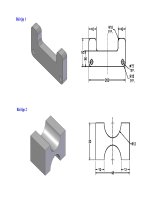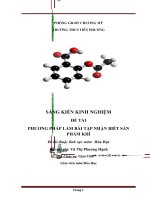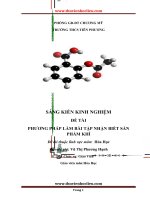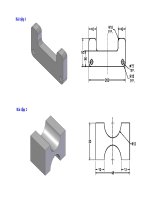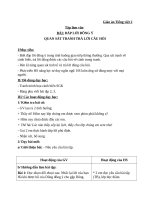Bài tập marketing management sản xuất – dòng sản phẩm – khái niệm tiếp thị xã hội
Bạn đang xem bản rút gọn của tài liệu. Xem và tải ngay bản đầy đủ của tài liệu tại đây (121.13 KB, 12 trang )
BÀI TẬP MARKETING MANAGEMENT: SẢN XUẤT – DÒNG SẢN PHẨM –
KHÁI NIỆM TIẾP THỊ XÃ HỘI
Explain the following:
(a) Production concept
(b) Product line.
(c) Augmented Product
(d) Social marketing concept.
Answer questions 1:
a/Production concept:
Economic standpoint: Manufacturing is the process of creating products and services that
meet the needs of society.
Marketing standpoint: Manufacturing is activities in order to create value and benefits for
customers which to achieve targets of profit for the businesses. Thus, according to
marketing standpoint, activities which do not bring value and benefit to customers are not
considered to be the production. (Philips Kotler Marketing book)
* In essence, the manufacturing is the processes of transforming the inputs, then,
changing them into the outputs under the form of products or services.
b/Product line:
The product line is a series of the same products about the structure, function, shape,
and characteristic that can be readily identified.
For example, computers have a lot of categories, so that customers are aware of the
manufacturer. Therefore, every company produces its own a certain product lines such as
Dellx130, Sony, Acer5100, Hp 5600, Nokia x, y, z, iPhone 5S.
A group of related products manufactured by a single company.For example, a
cosmetic company's makeup product line might include foundation, concealer, powder,
blush, eyeliner, eyeshadow, mascara and lipstick products that are all closely related. The
same company might also offer more than one product line. The cosmetic company might
have a special product line geared toward teenagers and another line geared toward
women older than 60, in addition to its regular product line,that can be used by women of
any age.
Investopedia explains 'Product Line'
A good way for a company to try to expand its business is by adding to its existing
product line. This is because people are more likely to purchase products from brands
with which they are already familiar. For example, a frozen pizza company may wanted
to increase its market share by adding frozen breadsticks and frozen pastas to its product
line.
c/Augmented Product
Definition of 'Augmented Product'
A commodity that has both the primary physical attributes and the non-physical attributes
that are added to increase the product's value. Non-physical attributes of an augmented
product may include a product warranty, service or installation, and may increase the
price of the basic product being purchased, and allow the company selling the good to
provide the consumer with other services that may make using the product easier.
Investopedia explains 'Augmented Product'
A consumer has a host of choices across a wide price range when purchasing this type of
electronic. In order to differentiate themselves from the competition, companies selling
computers will augment the basic computer - the actual product - with warranties,
customer service hotlines and other add-ons in order to make their products stand out.
The consumer then has the choice of buying a basic computer or an augmented product
that has more bells and whistles. A company's success in selling an augmented product is
heavily dependent on consumer perception of the value the add-ons bring, which makes
marketing the product very important.
d/Social marketing concept:
According to Philip Kolter in 2002, there is a definition about social marketing. It is said
that social marketing is the use of the marketing principles and techniques in order to
influence their target audience to accept, refuse, modify, or remove a certain voluntary
action, which is useful for individuals, groups or society.
According to Alan Andreasen in 1995, there is a definition more academic. It is said that
Social marketing is the application of marketing techniques into business through the
analysis, planning, implementation and evaluation of programs which are designed to
influence the voluntary behavior of target groups in order to bring the greatness to them
and society in which they are members.
According to Nedra Kline Weinreich in 1999, there is a simple definition of social
marketing. It is said that social marketing is the use of marketing techniques to
encouragement about consensus about a certain behavior to improve health and happiness
for every member in the society.
Questions 2: Explain difference in marketing concept, along with suitable examples.
Marketing is a good product is sold in convenient places for the right people to buy
for a reasonable price.(Adcoketal).
For example, a business enterprise which products branded goods brings its own goods to
guests in rural areas having low income. This activity of business enterprise proved that it
does not understand about marketing. It does not sell what the customer needs it just sells
only what they have.
Marketing is the activity aimed towards to the satisfying of customer needs and
wants through the processes of interaction exchange. (Kotler1980).
For example, that continuous improvement Activities in order to bring products to
customers more benefits rather than old times is done in corporate marketing activities.
For example, EVN is equipped with electronic galvanometer for customers to be more
favorable, not wasting of time for writing a monthly index; besides, it increases the
confidence of customers towards EVN about the monthly amount of electricity. That is
marketing. To achieve this, there must be surely from EVN staff that working in market
research, customer research and effective marketing strategy.
Marketing is a task in the organizational structure and a set of processes in order to
create, exchange, convey value to customers, and for managing customer relationships in
different ways to bring the benefits to the organization and the members of the General
Meeting of Shareholders. (American Marketing Association - American Marketing
Association, 2008)
For example, Honda is always a pioneer in the introduction of new product lines, which
is known the 2-wheel vehicles in Vietnam. Honda has improved from designs, modern
technology (Product), to cheaper price (Price). Furthermore, nowadays, people want to
buy HONDA wherever in the city (Place). When talking to the 2-wheel vehicles,
Vietnamese wants always referred to the name of HONDA SUZUKI whether it is or what
other effects. This evidence shows that Honda has done good job at promotion
(Promotion). Eventually, what causes the development of HONDA today, surely
everyone can understand.
Questions 3: Explain the market segmentation and suitable examples.
Businesses today realize that they can not attract all buyers in the market, or at least
they can not coexist in a way that can attract all shoppers. Buyers are too large in number
and too scattered geographically, needs and buying their products too varied. On the
business side, the ability to meet the needs of the market they are also different because
they differ in capacity and expertise.
So instead of spreading capacity to cater to the entire demand in the market, each
enterprise should identify themselves part of the market (also known as a segment) that
they have the ability to serve The best service, the most profitable. Part markets that a
business choose to compete is called the target segment.
Thus, we can say the target market segments in order to determine which market
segment will now compete and do business segments will not competition.
Market segmentation is:
Sort customers into groups (market segments) based on their motivation (purchase, select
supply goods (products, services, ideas ...)
Sort into groups based on client needs (Strategic needs, unmet needs, unsatisfied needs of
the body) and behavior (Behavioural segmentation) of them.
Sort customers into groups based on the determinants that they set out to (purchase of
goods, supplies select products, services ...)
Segmentation process also requires workers to understand the market factors selected and
preferred customer in the market, thereby discovering the basis of competitive advantage.
Market segmentation helps marketers see the opportunities in the job market through
analysis of the needs of each customer group. So we can offer the same products but have
different uses, different packaging, different prices etc.
Market segmentation is the basis for marketers to identify, assess markets, helping to
track market movements, to judge changes in the market in order to prepare for future
market demands.
There are many possible ways to segment the market, based on many different grounds
(anthropology, behavior, needs, habits, attitudes, purchase criteria, purchase process ...).
The work needs to identify the market segment criteria accordingly.
For example, in the automotive market, we can see that in the highest segment, it has
Maybach, Rolls Royce, etc. The next segment is the senior market such as Mercedes,
BMW, and Audi, etc. Then, the segment with medium - high level is Toyota, Honda, Ford.
Besides, the low segment includes Kia Motors, the low quality and perishable automaker
from China.
Summary: Market segmentation or target marketing is the opposite concept of mass
marketing and marketing various products. The objective of market segmentation in
marketing market is to divide it into smaller segments, easy identification in order to
catch the demand and respond more effectively without any trouble. Because resources of
the company are limited, they cannot meet all markets; furthermore, every business has a
different strength which is also a difference in comparison with the competition. Hence,
to effectively meet the needs of the market, businesses should segment the market,
choose the target market in order to compete effectively and survive sustainably rivals.
Questions 4: “PLC as a tool for marketing strategy” justify
A. Product life – cycle.
Life cycle of the product (the typical product life - cycle, abbreviated as PLC) is a key
concept of marketing.No help managers better understand the marketing campaign
process and product variability on market dynamics and competition of rival approaches
necessary for the business of the various stages of the product life cycle.
Product life cycle vivid description of the stages in the process of a real product.
Corresponding to these periods as opportunities and problems to be solved for marketing
strategy and fertility profits
Typical life cycle of a product sinusoidal and divided into four distinct phases:
a. About the product phase has been introduced in the market. During this period sales
growth slows, less profitable because the cost to much for the introduction of products to
the market.
b. Development stage products is receiving markets quickly and significantly increased
profits.
C.Prolific period sales are slowing down, because the product is most acceptable
prospect. Profits stabilize or decrease due to increased marketing expenses to protect
products against competitors.
d. The decline stage sales tend to decline and diminishing returns. The concept of life
cycle can be expressed through the concept of product categories (gasoline car) type
products (cars with roof unfinished), or label products (Mustang car).
The shape of the product life cycle
Type "development - a sudden drop-saturated"
Type "cycle - the cycle repeats"
PLC configuration wave form represents the sales of products that we go through a life
cycle sequence for discovering the new features of the product, the new use or new users.
For example, there is a plastic life cycle of wavy, because it has more new uses such as
umbrellas, socks, underwear, shirts, carpets ... detected over time.
B. The marketing strategy according to the product life cycle
In this section, we will examine the main characteristics of each stage in the life cycle
of the product and marketing strategies corresponding to each time period.
a. Introduction period
This period begins when a new product was first sold in the market. Introduce it takes
some time so the increase in sales will be slowed.In this period, rates may be negative or
very low because sales at the distribution costs and higher advertising.
At this stage, only a few competitors and they can produce the goods is essentially the
same with new items for this market are not suitable for industrial innovation focus on
product.Company concentrates on customers ready to buy one, usually the high-income
customers. Prices tend to be high because: high cost due to the relatively low yield;
technical problems in production can still unfinished; should have high interest rates to
offset large expenses advertising costs as necessary to achieve development ".
Rapid skimming strategy is the strategy of launching new products to market with
initial high prices and high level of fans. Enterprise features to ensure high rates of gross
profit per unit of product at the highest level.
Rapid penetration strategy is the strategy of launching new products to the market
with high-level supporters and initial low price, hoping to achieve rapid penetration rate
and a large share of this strategy is only the most suitable. This strategy should be applied
when the major markets are huge and products not known.
Slow penetration strategy is the strategy of launching new products into the market
with low initial price and low level fans. Low prices will encourage consumers quickly
accepted products, low cost shareholders to achieve higher net income.
b. Developing period
If a new product to meet the expectations of the market, sales will start increasing
rapidly. Those who respond early will continue to buy more, other customers will start
buying follow, especially when they hear the praise that product. These new competitors
will enter the market penetration opportunity to find and produce high profits. They will
introduce additional products with new features, building more selling point, and this will
make the market expanded. The number of people increased competition also increases
the retail hub of business and production have also shot up to provide full customer
wishes.
Increase in profits during the development phase, when advertising costs are
calculated on large volume, production costs per unit calculation is further reduced by
"accumulated experience". Late stages of development, the level of increased slowly and
businesses prepare new strategies for the next stage spikes.
During the development phase, enterprises can deploy a number of marketing
strategies to prolong the rapid growth of the market
c. Prolific period
Up to a certain point, an increase of product sales will slow down and enter the
product relatively prolific period. This stage usually lasts prolific than the previous stage,
posing hardships for marketing executives. Most products are in mature stage of the life
cycle and nearly the entire job in marketing management are aimed at solving the
problem of the product in that prolific period.
In the mature stage, firms often seek to eliminate weak products and focus resources
on more profitable products, and sometimes disregard the enormous potential of existing
old products themselves. Marketers need to consider a system of market strategy, product
and marketing improvements - mix
-Market innovation
Enterprises try to improve existing products consumed in two ways: increasing the
number of people using the product and increase the use of each person.
- Product innovation
The marketing managers can also innovation of product attributes such as quality,
features, styling to attract new customers and get more use.
- Improved marketing mix
The marketing managers can also stimulate sales by improving some elements of
coordination of marketing (marketing – mix)
-Price: Enterprises should consider the possibility of lower prices to attract new
customers and customers of competing firms.
d. Decline period
After some time on the market, most of the products and brands will gradually
reduce its sales. The sales decline may be faster or slower, or stable at a low level for a
long time, but basically no longer profitable as before. It is an expression of the decay
phase.
Sales may decline for many different reasons, such as technological innovation,
changing customer preferences, competition is increasing. It all led to surplus production
capacity, increasing product prices down leading to the rapid decline of profits.
Summary: The different products have different life cycle stages of the life cycle have
different length or short, consumption and profits in the different stages and different. It
also requires businesses to strategic marketing, financial, manufacturing, supply and
multiply the difference in each stage of the life cycle of each product accordingly.
Questions 5: Explain process of selecting the final price
When we develop a new product, and introduce into a market, we must setting the
price as follows:
+Identify the target market segment for the product or service.
+Establish the price range that would be acceptable to occupants of this segment.
+Examine the prices (and costs if possible) of potential or actual competitors.
+Examine the range of possible prices within different combinations of the
marketing mix.
+Determine whether the product can be sold profitably at each price based upon
anticipated sales levels.
+Maybe adjust something until costs are reduced sufficiently to produce the desired
profit.
We could goes through the following steps in setting the price:
a. Selecting the pricing objective: The foremost step is identifying pricing objectives.
The clearer a firm’s objectives, the easier it is to set price. What are pricing
objectives? A company can pursue any of five major objectives through pricing:
survival, maximum current profit, maximum market share, maximum market
skimming, or product-quality.
b. Determining demand: Each price will lead to a different level of demand and
therefore have a different impact on a company’s marketing objectives. In the normal
case, demand and price are inversely related.
The customers usually are price-sensitive to products that cost a lot or are bought
frequently? The process of estimating demand therefore leads to:
-Estimating Price sensitivity of market
-Estimating and analyzing demand curve
-Determining price elasticity of demand.
c. Estimating costs: Normally, we want to charge a price that covers its cost of
producing, distribution and selling the product, including a fair return for its effort and
risk. As you know, a product’s cost take two forms, fixed and variable.
To price intelligently, management needs to know how its costs vary with different levels
of production.
d. Analyzing competitors’ costs, prices, and offers: Analyzing competitor’s costs,
prices and offers is important factor in setting prices . Within the range of possible
prices determined by market demand and costs, we must take the competitor’s costs,
prices and price reactions. Be aware that competitors might even change their prices
in response to your price.
e. Selecting a pricing policy and method
There are three pricing methods that can be employed:
-Cost Oriented Pricing
-Competitor Oriented Pricing
-Marketing Oriented Pricing
+Cost Oriented Pricing: Companies often use cost oriented pricing methods when
setting prices. Two methods are normally used: i) Full cost pricing, the company
determines the direct and fixed costs for each unit of product. The first problem with
Full-cost pricing is that it leads to an increase in price. This method focuses upon the
internal costs of the company as opposed to the prospective customers’ willingness to
pay. ii) Marginal Cost Pricing - This involves the calculation of only those costs, which
are likely to increase as output increases.
+Competitor Oriented Pricing: The company bases its price largely on competitors’
prices, with less attention paid to its own costs or to demand. The firm might charge the
same, more, or less than its major competitors. The company may attempt to
differentiate on delivery or service quality in an attempt to justify a higher selling price.
+Marketing Oriented Pricing: The price of a product should be set in line with the
marketing strategy. The danger is that if price is viewed in isolation (as would be the case
with full cost pricing) with no reference to other marketing decisions such as positioning,
strategic objectives, promotion, distribution and product benefits. The way around this
problem is to recognize that the pricing decision is dependent on other earlier decisions in
the marketing planning process. For new products, price will depend upon positioning,
strategy, and for existing products price will be affected by strategic objectives.
f. Selecting final price: Pricing methods narrow the range from which the company
must select its final price. In selecting that price, the company must consider
additional factors, including psychological pricing, gain and risk pricing, the influence
of other marketing -mix elements on price, company -pricing policies, and the impact
of price on other parties.
REFERENCES
- />song-cua-san-pham 12/05/2014
- />13/05/2014.
-Web:
-Thư viện Wikipedia.
-Tailieu.com.
-
-Trang web:
-investopedia.com 17/05/2014

